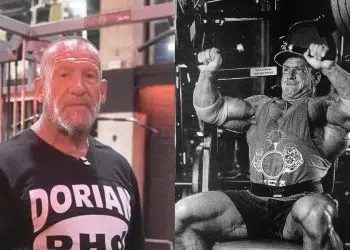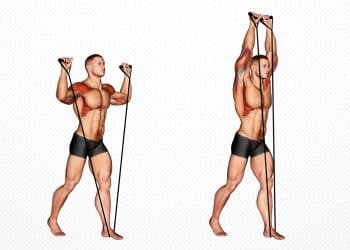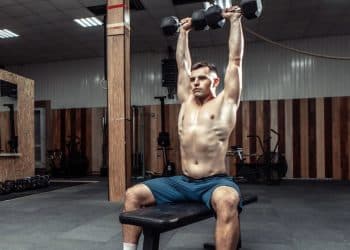Broad shoulders have been a symbol of strength and toughness since time immemorial. Wide shoulders can also help accentuate your V-taper by making your waist look smaller.
However, building boulder shoulders is easier said than done. Most shoulder exercises, like the Arnold press and seated dumbbell press, are complex and require years of practice to master.
Performing compound lifts with an incorrect form can increase your odds of injury. On the flip side, isolation lifts like the side lateral raise and cable rear delt fly aren’t as effective as the compound movements at building muscle mass.
This is where the shoulder press machine shines. It is a compound exercise that can help build 3D shoulders. The fixed movement path of the machine lets you focus on the target muscles while limiting the chances of injury.
What is a Shoulder Press Machine?
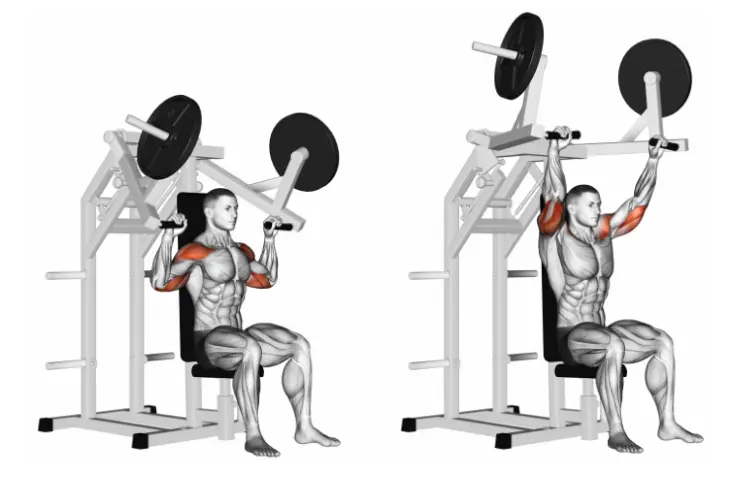
The shoulder press machine, also known as the machine shoulder press, is great for inducing hypertrophy and building strength. Most commercial gyms have a shoulder press machine in their equipment arsenal.
It is a variation of the seated dumbbell shoulder press. The machine’s fixed trajectory and ability to handle heavy loads make it optimal for beginners and advanced lifters alike.
Level Up Your Fitness: Join our 💪 strong community in Fitness Volt Newsletter. Get daily inspiration, expert-backed workouts, nutrition tips, the latest in strength sports, and the support you need to reach your goals. Subscribe for free!
Contrary to what most lifters think, the machine shoulder press requires skill and practice. As you’ll learn later in this article, the machine shoulder press isn’t as simple as pushing your hands overhead and repeating this motion for the desired reps. You need to learn the proper form and focus on nailing your technique to get the best bang for your buck.
Shoulder Press Machine Exercise: Muscles Worked
The machine shoulder press is a compound exercise, meaning it engages multiple muscles throughout the range of motion, including:
1. The Three Deltoid Heads
Your shoulders consist of three heads — anterior, medial, and posterior. As the names imply, the anterior delts are in the front of your shoulders, the posterior is in the rear, and the medial lie between its other two siblings. Given below are the primary roles of the three delt heads:
- Anterior Delts: They help move the arms forward.
- Medial Delts: They help move your arm out to the side and up and down.
- Posterior Delts: They help move your arm backward.
Notably, the anterior and medial delts are the main shoulder muscles recruited during the machine shoulder press, while the rear delts take a back seat.
2. Triceps
The triceps are present at the back of your upper arm. These muscles drive most of the pressing movements. This overhead pressing movement only activates the medial and lateral triceps heads.
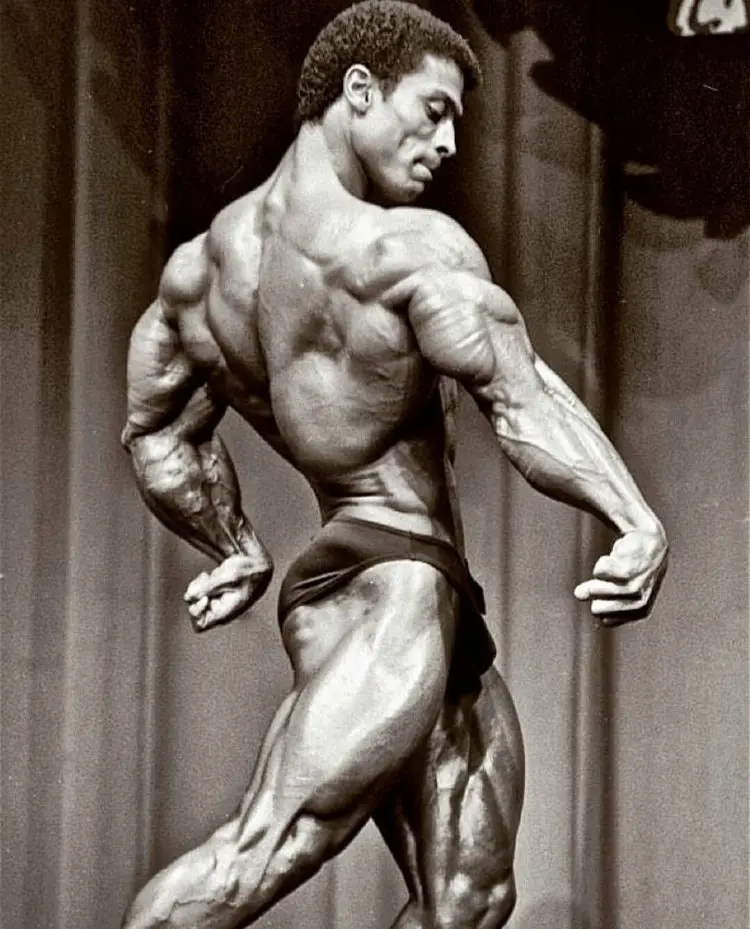
3. Trapezius
The trapezius starts at the base of your neck, goes across your shoulders, and extends to the middle of your back. It is recruited while performing this exercise.
4. Upper Chest
Most shoulder press machines are set at a slight incline, which results in an upper pec activation. Many lifters report greater upper chest stimulation while performing the machine shoulder press while lifting relatively heavier.
How To Perform Shoulder Press Machine
This is how to perform this lift with the perfect form:
- Adjust the seat to the right height. The weights should not stack at the bottom of the range of motion.
- Sit upright on the chair.
- Grab the handles with a pronated (palms facing forward) grip. Alternatively, you could use a neutral (palms facing each other) grip.
- Place your feet flat on the floor so your heels are under your knees. It will help generate more power.
- Take a deep breath, tighten your core, and push the handles overhead. However, do not lock out your elbows at the top.
- Pause at the top and contract your shoulders.
- Slowly return to the starting position.
- Repeat for recommended repetitions.
Pro Tips:
- Pull your shoulders back and down and contract your shoulder blades as if holding a pencil between your rhomboids. Maintain this position throughout the exercise.
- Push your chest out slightly and drive your upper back into the back pad. It will help maintain stability throughout the movement.
- Maintain your lower back’s natural arch while performing the lift. There should be enough distance between your lower back and the back pad for your hand to pass through.
- Furthermore, keeping your head pinned to the machine’s back pad will allow optimal anterior and medial deltoid recruitment by improving your range of motion.
- Keeping your elbows under the handles ensure stability.
- Slow down the eccentric (lowering) part of the motion to four seconds, eliminate the pause at the bottom, explode back to the top, and hold it there for a second to get the most out of this exercise.
- Many people make the mistake of moving their heads back and forth while using the shoulder press machine. It can put unnecessary stress on your neck and traps.
- Target Muscle Group: Shoulders
- Secondary Muscles: Traps and Triceps
- Type: Strength
- Mechanics: Compound
- Equipment: Machine
- Difficulty: Beginner
- Best Rep Range:
- Hypertrophy: 8-12
- Strength: 1-5
Types of Shoulder Press Machines
There are two main types of shoulder press machines found in gyms:
- Selectorized Shoulder Press Machine: This type of machine has an in-built weight stack and a pin to select the appropriate weight. Selectorized machines generally operate using a cable mechanism.
- Plate-Loaded Shoulder Press Machine: As the name suggests, plate-loaded machines use weight plates for resistance. Many elite bodybuilders prefer these machines over the selectorized ones as they can handle more weight.
Benefits of Shoulder Press Machine
Given below are the benefits of adding the machine shoulder press to your training regimen:
1. Helps Build Bigger and Stronger Shoulders
This is why we lift weights, isn’t it? The shoulder press machine is an incredibly effective tool to help build shoulder strength and muscle mass.
The shoulder press machine primarily targets the anterior and medial deltoids, and you’ll see the first signs of aesthetical improvements in your physique in these two muscle groups.
2. Follows a Fixed Trajectory
Since the shoulder press machine follows a fixed motion path, it can help establish a mind-muscle connection with your shoulders. You should add this exercise to your exercise arsenal if you have trouble achieving a shoulder pump while training.
3. Maintains Constant Tension on Your Shoulders
While performing the seated shoulder press with dumbbells, many people finish the movement with the dumbbells above their thighs at the top. This removes the tension from your shoulders and puts it on your traps and upper back. Nonetheless, using the shoulder press machine negates this issue and helps you maintain constant tension on your delts throughout the range of motion.
4. Lowers Your Risk of Injury
Performing overhead presses with dumbbells and barbells requires you to use a strict form, which makes beginners susceptible to injury while performing these exercises. However, the shoulder press machine fixes this issue as lifters don’t have to focus on stabilizing their core while performing this exercise and can instead focus on pressing the weights overhead.
On the other hand, a shoulder press machine is also a great tool for people dealing with injuries. You could limit the range of motion of the shoulder press machine to boost shoulder rehabilitation.
5. Great For Unilateral Training
Most shoulder press machines use an isolateral mechanism, meaning you can move each handle independently. Unilateral training is an incredibly effective method of fixing muscle and strength imbalances.
Level Up Your Fitness: Join our 💪 strong community in Fitness Volt Newsletter. Get daily inspiration, expert-backed workouts, nutrition tips, the latest in strength sports, and the support you need to reach your goals. Subscribe for free!
Common Mistakes While Performing Shoulder Press Machine
Here are some of the most common errors lifters commit while performing the machine shoulder press:
1. Not Following a Full Range of Motion
Many lifters stack on more weights than they can handle while performing the machine shoulder press, which limits their range of motion. Following a restricted ROM limits your muscle fiber recruitment, resulting in suboptimal muscle and strength gains.
2. Elbows Pointing Forward
Ensure that your elbows are not facing forward while performing the machine shoulder press as it can limit your anterior and side delt engagement and puts more focus on your triceps. On the flip side, your elbows shouldn’t be flared too wide as it can put unnecessary tension on your shoulder rotator cuffs. Find a happy medium between both positions to achieve optimal shoulder recruitment.
Variations and Alternatives of Shoulder Press Machine
Performing the machine shoulder press in each workout can get redundant and lead you to a muscle and strength plateau. Spice up your workouts with these variations and alternatives:
1. Seated Dumbbell Shoulder Press
No surprises here. The shoulder press machine is a seated dumbbell shoulder press variation. This exercise is a staple in most shoulder training routines, and for good reason.
Steps:
- Sit on a military chair and position a dumbbell on each knee. Grab the dumbbells with a neutral (palms facing each other) grip.
- Kick your knees up one at a time to get each dumbbell at shoulder level.
- Once both dumbbells are at shoulder level, rotate your palms so they are facing forward.
- Press the dumbbells overhead by extending your elbows.
- Pause and contract your shoulders at the top.
- Slowly return to the starting position.
- Repeat for recommended reps.
Pro Tip: Keep constant tension on your shoulders by ensuring you don’t rest for too long at the top or bottom.
Check out our complete dumbbell shoulder press guide here!
2. Military Press
The military press is one of the OG shoulder exercises. This exercise is also known as the overhead press or strict press.
Steps:
- Grab the bar with a pronate shoulder-wide grip (palms facing forward).
- Get into the starting position by assuming a shoulder-wide stance. The bar should be right above your shoulders.
- Take a deep breath and brace your core as you press the bar to lock out overhead.
- Exhale and contract your shoulders at the top.
- Slowly return to the starting position.
- Repeat for recommended reps.
Pro Tip: The word ‘military’ in this exercise’s name is no coincidence. You need to ensure that you are not using momentum by jerking your knees while performing the military press.
Check out our complete military press guide here!
3. Smith Machine Shoulder Press
The Smith machine shoulder press is arguably the closest shoulder press machine alternative. Unlike most shoulder press machines, the Smith machine barbell doesn’t move in an arc.
Steps:
- Set a military chair in the center of the Smith machine under the barbell so the bar comes down just in front of your face.
- Grab the bar with a wider-than-shoulder-width pronated grip.
- Unrack the barbell and lower the barbell toward your upper chest by bending at your elbows.
- Explode back to the starting position.
- Pause and contract your shoulders at the top.
- Repeat for desired reps.
Pro Tip: The multiple racking positions of the Smith machine makes it beginner-friendly.
Check out our complete Smith machine shoulder press guide here!
4. Behind-the-Neck Barbell Press
This advanced shoulder exercise focuses on the anterior deltoids. You should not attempt this lift if you lack shoulder mobility and have stiff shoulder rotator cuffs.
Steps:
- Set a military chair inside a squat rack and adjust a barbell at shoulder height.
- Grab the bar with a shoulder-wide pronated grip.
- Unrack the bar and press it to lock out overhead.
- Bend at your elbows and slowly lower the bar behind your head.
- Lower the bar as far as possible comfortably.
- Return to the starting position.
- Repeat for desired repetitions.
Pro Tip: We recommend performing this exercise while seated to limit the moving parts and lower the risk of injury. Keep your chin tucked in to avoid banging the bar into your head.
5. Single-Arm Landmine Press
The single-arm landmine press is a great exercise for people with shoulder mobility issues or lifters dealing with injuries.
Steps:
- Set a barbell in a landmine attachment. Load an appropriate weight on the other end of the barbell.
- Stand with a shoulder-wide stance at the free end of the barbell.
- Grab the end of the barbell with both hands and bring it to your right shoulder level.
- Release your left hand and place it on your left hip.
- Press to lockout by extending the elbow and flexing the shoulder.
- Pause and contract your shoulder at the top.
- Slowly lower the barbell to the starting position.
- Repeat for recommended reps before switching sides.
Pro Tip: Keep your torso stationary throughout the exercise. Moving the working side back and forth throughout the lift reduces the focus on the shoulder.
Check out our complete landmine press guide here!
Frequently Asked Questions
Is the shoulder press machine better than the military overhead press?
The standing military overhead press engages more muscles than the shoulder press machine. Furthermore, even the seated military press engages your stabilizers. Although the military overhead press is superior to the shoulder press in muscle recruitment and stimulation, both compound exercises deserve a place in your exercise regimen.
Can I replace the dumbbell overhead press with the shoulder press machine?
Like the military press, the seated dumbbell overhead press results in broader upper-body muscle recruitment. However, the shoulder press machine can add variety to your training regimen and is a great option for people with shoulder injuries. Do not choose one over the other.
Wrapping Up
The shoulder press machine is an incredibly effective exercise to build muscle mass and strength. It helps establish a mind-muscle connection and is better at keeping constant tension on your shoulder than the dumbbell shoulder press.
Make the most of this exercise by incorporating progressive overload and advanced training techniques like supersets, dropsets, etc. in your training regimen. Add the machine shoulder press and its variations and alternatives into your training regimen to take your shoulder gains to the next level.
Interested in measuring your progress? Check out our strength standards for Bench Press, Arnold Press, Seated Dumbbell Shoulder Press, and more.



